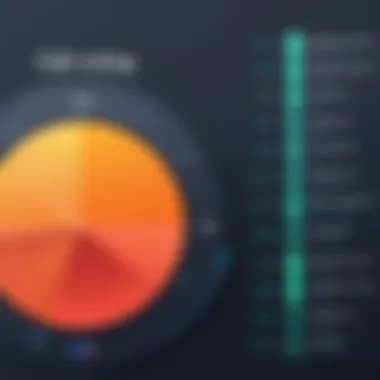Top Call Recording Solutions: An In-Depth Review


Intro
In an era where communication is crucial, the need for reliable call recording solutions has become apparent. Organizations must navigate compliance, quality assurance, and training. This article explores the top players in the call recording software market. It aims to provide decision-makers, IT professionals, and other relevant parties with a foundation to make informed choices. The analysis focuses on the features, advantages, and drawbacks of these solutions.
Understanding these nuances is essential. Therefore, we will examine various aspects of these platforms and the potential impact on organization.
Key Features and Functionalities
Comprehensive Overview
Call recording solutions vary significantly in their offerings. Key features generally include
- Call transcription
- Data encryption
- User-management capabilities
- Integration with customer relationship management (CRM) systems
- Analytics and reporting tools
Each solution must balance these functionalities based on the target audience. Some are designed for small businesses, while others cater to large enterprises with complex structures. The flexibility to adapt to user needs is a critical component.
Target Users
These solutions serve various roles and sectors. Small and medium-sized enterprises (SMEs) often favor software that prioritizes simplicity and cost-effectiveness. Meanwhile, larger organizations may require advanced functionalities like team collaboration, voice recognition, or compliance management features.
The demand for call recording solutions spans many industries, including finance, healthcare, and customer support. Thus, understanding the intended audience is crucial for selecting the right platform.
Pricing Models and Cost Analysis
Breakdown of Pricing Tiers
Pricing models for call recording solutions come in different forms. Many providers offer subscription-based pricing, where users pay monthly or annually. There are typically three tiers to consider:
- Basic: Affordable entry-level features for start-ups and SMEs.
- Standard: Enhanced capabilities with more user seats and storage.
- Premium: Comprehensive solutions tailored for enterprises with highest requirements in compliance and analytics.
Each tier should align with the organizational goals, ensuring that users only pay for necessary functions.
Additional Costs to Consider
While subscription costs are clear, other expenses may arise. Additional costs can include:
- Setup and installation fees
- Training for staff
- Additional storage for recordings
- Integration with existing software systems
It is vital to account for these potential costs during the budgeting process. Thorough planning allows organizations to choose a solution that fits both functionality and budget.
"Informed decisions stem from understanding both benefits and costs associated with call recording solutions."
By examining these key elements, organizations can make strategic choices that improve communication practices and compliance efforts.
Prologue to Call Recording
Call recording is an essential component in today’s business communications. With the rise of digital technology, the ability to record calls has evolved significantly, providing businesses with numerous benefits. This article delves into the nuances of call recording solutions, exploring their implications on communication quality, compliance, and overall business efficiency.
Call recording serves multiple purposes in a corporate environment. Firstly, it enhances customer service by allowing agents to review interactions. This can lead to improved techniques and enhanced customer satisfaction. Secondly, these recorded calls can be vital for training new employees. When they can listen to real conversations, they can better understand customer needs and expectations.
Another significant aspect is the ability to resolve disputes. Recorded calls provide evidence in case of misunderstandings or complaints. This can protect both companies and consumers, fostering a better business relationship. The utility of these recordings extends beyond just customer interactions. Internal communications can also benefit. For instance, management can evaluate team performance and identify areas for improvement.
However, it is not enough to simply implement a call recording system. Understanding the legal ramifications is crucial. Businesses must ensure they comply with national and international laws regarding privacy and data protection. This means that companies should have clear policies in place, informing their employees and customers that calls are being recorded. Additionally, having a system that adheres to legal standards adds credibility to the organization.
In summary, call recording is vital for businesses aiming to enhance communication quality and compliance. With numerous solutions available, selecting the right one becomes a vital task. In the next sections, we will explore the various types of call recording solutions available.
Types of Call Recording Solutions
Understanding the different types of call recording solutions is crucial for businesses looking to enhance their communication strategy. Each solution has unique features, benefits, and limitations that cater to varying needs. By knowing these options, decision-makers can make informed choices that align with their operational goals.


On-Premises Call Recording
On-premises call recording involves installing software and hardware within the company's own infrastructure. This solution offers businesses full control over their data. Many organizations prefer this due to perceived security advantages. The critical aspects to consider include:
- Data Security: Control over sensitive information is paramount. On-premises solutions often boast robust security protocols that may reduce the risk of data breaches.
- Customization: Companies can tailor the system to their specific needs, allowing for varied call recording criteria and storage options. This flexibility is appealing to those with complex requirements.
- Initial Cost: The upfront investment for hardware and software can be significant. Companies must weigh this against long-term benefits.
- Maintenance: Ongoing maintenance of the system falls on the organization. This can lead to increased operational complexity and costs.
On-premises solutions serve best those companies seeking control and customization, especially in industries where security and compliance are serious concerns.
Cloud-Based Call Recording
Cloud-based call recording has gained considerable traction in recent years due to its scalable nature. In this model, the recording services are hosted in the cloud, offering several distinct advantages:
- Flexibility: This solution allows businesses to scale services up or down based on their needs easily.
- Lower Initial Costs: Companies generally face a lower barrier to entry. They save on hardware costs and maintenance efforts since the cloud provider manages these aspects.
- Remote Access: With a cloud setup, employees can access recordings from anywhere, facilitating collaboration and ensuring continuity in communication.
- Regular Updates: Most cloud solutions offer regular updates and improvements, ensuring businesses stay current with technological advancements.
- Subscription Fees: Costs are typically structured as a subscription, which can seem advantageous but may add up over time.
Cloud-based solutions appeal to businesses that need agility and reduced upfront investments, particularly those with remote or distributed teams.
Hybrid Solutions
Hybrid call recording solutions combine both on-premises and cloud methodologies. Organizations choosing this path find they can leverage the strengths of both systems. Consider the following:
- Balanced Approach: Businesses retain control of critical data on-premises while utilizing cloud capabilities for scalability. This can enhance security while improving flexibility.
- Seamless Integration: Hybrid solutions can integrate with existing on-premises systems, reducing disruption during implementation.
- Cost Management: Companies can manage costs more effectively by selectively migrating to the cloud as needed.
- Data Backup and Recovery: The dual nature of a hybrid system often allows for better data backup options, enhancing recovery strategies in case of a failure.
- Complexity: While offering benefits, managing a hybrid system can require more technical knowledge and resources. This may lead some businesses to hesitate in implementation.
In essence, hybrid solutions are ideal for businesses looking for a versatile and balanced approach to call recording, particularly those with fluctuating needs or diverse operational environments.
Key Features to Consider
When evaluating call recording solutions, several critical features must be taken into account. These features impact the efficacy, compliance, and usability of the recording systems. Decision-makers should prioritize these elements based on their organizational needs and operational contexts.
Recording Quality and Formats
Recording quality is paramount for any call recording solution. High-definition audio ensures clarity, allowing organizations to capture conversations accurately. This is particularly essential for sensitive sectors like finance and healthcare, where details matter. Call recordings should support multiple formats, such as WAV and MP3, to offer flexibility in storage and retrieval.
Poor audio quality may lead to misunderstandings or compliance issues. Choosing a solution that guarantees pristine recording quality is essential. Considerations should also include the ability to select different quality levels based on bandwidth availability.
Integration with Other Software
For an effective workflow, integration with other enterprise software is vital. Whether it be customer relationship management (CRM) tools like Salesforce or ticketing systems like Zendesk, seamless integration allows recorded calls to become part of a broader operational framework.
This not only enhances productivity but also improves data accessibility. Users should look for solutions that support APIs or have out-of-the-box integrations. A lack of integration can result in siloed information, creating inefficiencies.
User Interface and Experience
A user-friendly interface is crucial for ensuring that employees can easily navigate the system. Call recording solutions should prioritize simplicity and accessibility. An intuitive design enables faster training and less friction when adopting new technology. The interface should provide straightforward options to start, stop, and locate recordings.
Moreover, providing mobile access and multi-device compatibility is an important consideration. Many users may need to access recordings on-the-go, necessitating a well-designed mobile version of the application.
Data Security Measures
Data security cannot be overlooked in the current landscape filled with data breaches and regulatory scrutiny. Call recording solutions must include strong encryption protocols to protect stored data. Additionally, secure access controls should be in place to ensure that only authorized personnel can access sensitive recordings.
Compliance with regulations, such as GDPR or HIPAA, is another consideration. Organizations should seek solutions that provide compliance assurances and features designed to support secure data handling. Regular audits of security practices and reporting mechanisms can further reinforce organizational safety.
"Incorporating security measures into call recording solutions is not just about compliance; it is about protecting the company's integrity and customer trust."
In summary, assessing these key features—recording quality and formats, integration capabilities, user interface, and data security—is vital in selecting a call recording solution that meets both current and future organizational needs.
Comparative Analysis of Leading Solutions
In the realm of call recording technologies, it is essential to critically assess leading solutions to ensure optimal selection. The comparative analysis sheds light on various aspects of call recording software, helping decision-makers navigate through the complexities of features and capabilities of each option. This evaluation serves not just to inform users, but to equip them with necessary insights to tailor their choices to organizational requirements.


Identifying the right call recording solution requires understanding differences in functionalities, pricing models, and user experiences. Each solution plays a unique role, catering to various business needs. By comparing these options meticulously, one can ascertain the strengths and weaknesses pertinent to their environment.
Solution A: Overview and Features
Solution A stands out in the market due to its robust features designed for businesses of all sizes. It promises a user-friendly interface, which significantly impacts user adoption. The standout feature of Solution A is its exceptional recording quality. It supports multiple formats including MP3 and WAV, ensuring compatibility with various playback systems. Moreover, it offers seamless integration with popular Customer Relationship Management software, enhancing overall productivity.
Key features include:
- Customizable Recording Settings: Tailor the solution to record specific calls based on parameters like time, urgency, or customer requests.
- Real-Time Monitoring: Enable supervisors to listen in on calls as they happen, which helps in maintaining quality assurance.
- Analytics Dashboard: Provides insights into call statistics, helping organizations understand customer interactions better.
Solution B: Pros and Cons
Solution B offers an extensive set of functions but comes with its own array of pros and cons.
Pros:
- Affordability: It presents a compelling pricing structure, which is scalable for small to medium enterprises.
- Cloud-Based Storage: The option to save recordings in the cloud ensures easy access and security.
- Mobile Application: Users can record calls on the go, amplifying flexibility for many modern workforce environments.
Cons:
- Limited Integration Options: It falls short in integrations compared to more advanced solutions, which might become a deciding factor for some users.
- Variable Recording Quality: Depending on the network, recording might experience fluctuations in quality, affecting reliability.
Solution C: User Experiences
User experiences with Solution C reveal a diverse perspective on its functionality. Many users commend its intuitive design, but also express concerns regarding its setup process. Qualitative feedback typically cites reliability in connectivity and recording clarity.
Key insights from users:
- Learning Curve: New users often report a need for training to fully utilize all available features. However, once familiar, many praise its effectiveness in improving compliance.
- Customer Support: Users generally appreciate the customer support provided, claiming timely responses and helpful solutions to inquiries.
- Real-Life Applications: Businesses in sectors heavily regulated, such as finance or healthcare, have reported a noticeable improvement in their compliance metrics after implementing Solution C.
In sum, the comparative analysis of these solutions offers a quintessential landscape of options available in the call recording market. With careful consideration, users can ascertain which solution aligns best with their business strategies, thus making informed decisions.
Cost Analysis of Call Recording Solutions
In the realm of communication technologies, a robust cost analysis of call recording solutions is essential. Decision-makers need to assess not only the expenditures linked to these systems but also the potential return on investment they can offer. This section delves into the specifics of pricing models and considerations that enhance value while ensuring compliance and operational efficiency.
Pricing Models Explained
Call recording solutions generally offer several pricing models that can fit diverse budget scenarios. Recognizing the right model is paramount for organizations aiming to maximize their resources. Common pricing structures include:
- Subscription-Based Model: This is one of the most prevalent models. Users pay a recurring fee monthly or annually, which typically covers maintenance and updates. It enables scalability without significant upfront costs.
- Per-User Licensing: In this structure, organizations are charged based on the number of users accessing the system. This can be particularly useful for businesses with fluctuating workforce sizes.
- One-Time Purchase: This model requires a larger initial payment, but it may not incur ongoing fees, except for updates and support. It suits organizations that prefer full ownership of their software.
- Pay-Per-Use: This is less common but offers flexibility by charging only for the recordings made during a specific period. It is an excellent option for companies with sporadic call volume.
Understanding these pricing models enables decision-makers not only to align their budget with their needs but also to anticipate future costs.
Cost-Benefit Considerations
Cost-benefit analysis plays a crucial role when selecting a call recording solution. Organizations must weigh the direct costs associated with each solution against the benefits derived from its implementation. Here are some elements to consider:
- Quality of Recordings: Ensuring high-quality audio can enhance training and compliance monitoring. The costs of solutions providing superior recording quality may be justified by the long-term gains.
- Integration Capabilities: Solutions that easily integrate with existing systems, such as CRM software, could lead to efficiency gains that outweigh their costs.
- Employee Productivity: Implementing a streamlined call recording process can free up employee time for more valuable tasks, indirectly adding to the organization’s bottom line.
- Regulatory Compliance: Non-compliance with call recording laws can lead to severe financial penalties. Investing in a solid solution can mitigate legal risks.
"The right call recording solution not only ensures compliance but also enhances operational efficiency, making cost analysis a vital component of the selection process."
By considering these factors, organizations can make more informed decisions that align with their financial objectives while maximizing operational effectiveness.
Implementation Challenges and Considerations
The implementation of call recording solutions might appear straightforward but involves several complexities. It is crucial for organizations to understand these challenges in order to ensure a smooth transition and to maximize the benefits of the chosen system. Addressing these elements can lead to better utilization of resources, improved compliance, and heightened employee satisfaction.
Being aware of the potential hurdles allows for proactive strategies, minimizing disruption while adopting new technology. As decision-makers examine their call recording needs, considerations relating to technical setup and the training of employees become paramount for success.


Technical Setup and Configuration
Setting up a call recording solution encompasses both technical and logistical components. Depending on the type of solution chosen—on-premises, cloud-based, or hybrid—a different approach to configuration is required.
Key considerations include:
- Network Infrastructure: Evaluate existing systems for compatibility. Ensure sufficient bandwidth for clear audio and minimize latency during calls.
- Integration with CRMs and Communication Tools: Successful implementation may rely heavily on integration with existing tools such as Salesforce or Zendesk. This can streamline data flow and enhance analysis.
- Hardware Compatibility: Determine if the current telephone system supports the chosen recording solution. Analog lines may require additional equipment while VoIP calls typically simplify implementation.
- Data Storage Considerations: Plan for data management, including storage solutions compliant with industry regulations.
Configuration may also differ across departments, requiring customized setups for unique needs. Therefore, it is important to approach implementation with flexibility and foresight.
Employee Training and Adaptation
Once the technical aspects are addressed, the focus shifts to human factors. Employee training is critical to ensure staff are comfortable using the new system and understand the extent of its features.
Considerations for training include:
- Hands-On Training Sessions: Provide opportunities for users to explore the system in a controlled setting. Real-life scenarios can aid in understanding functionality.
- Clear Documentation: Create user manuals and quick reference guides that are easily accessible. These documents serve as valuable resources for ongoing support.
- Feedback Mechanisms: Encourage employees to share insights about their experiences. This can guide future training sessions and identify areas needing additional focus.
- Cultural Adaptation: Foster an environment where employees feel comfortable discussing concerns about recording policies. Transparency around legal implications offers reassurance.
Employee adaptation goes beyond initial training; it is a continuous process. Ongoing support and adaptation strategies ensure that the call recording systems are fully exploited across the organization.
"Training personnel is as vital as technological advancements when adopting any new system. Skill set improvements guarantee a higher return on investment."
In summary, addressing the challenges of technical setup and employee adaptation is key to effective implementation. These considerations ensure that organizations position themselves for successful operation within the evolving landscape of call recording technology.
Future Trends in Call Recording Technology
The landscape of call recording technology is undergoing a seismic shift, driven by advancements in various digital fields. These changes influence how businesses approach communication, compliance, and customer service. A deep understanding of emerging trends is vital for organizations seeking to stay competitive. The integration of modern technology not only enhances operational efficiency but also provides valuable insights that can shape business strategies.
Artificial Intelligence and Call Analysis
Artificial intelligence is becoming a cornerstone in enhancing call recording solutions. AI algorithms analyze vast data from recorded calls, facilitating insights that were previously unattainable. Organizations can benefit from this technology in several ways.
- Sentiment Analysis: AI can evaluate the emotional tone of conversations. Businesses can adjust their customer service techniques based on the feedback derived from these analyses.
- Speech Recognition: AI-driven solutions offer advanced speech recognition capabilities. They can accurately transcribe calls, which simplifies record-keeping and allows for easier access to critical information.
- Automated Reporting: AI systems can generate reports summarizing call details. This automation saves time and enhances accuracy, allowing teams to focus on strategic initiatives rather than manual entry.
Adopting AI in call analysis leads to improved decision-making, allowing companies to tailor their services to meet customer needs effectively.
Enhanced Security Features and Compliance
As call recording becomes more integrated into business processes, security and compliance issues have come to the forefront. Enhanced security features ensure that sensitive information remains protected. Here are some important aspects:
- Data Encryption: Call recordings must be encrypted both in transit and at rest. This measure safeguards against unauthorized access and helps businesses comply with data protection regulations.
- Access Controls: Implementing strict access controls ensures that only authorized personnel can access sensitive recordings. This reduces the risk of data breaches and fosters accountability among users.
- Compliance with Regulations: Companies must comply with various legal frameworks, such as the General Data Protection Regulation (GDPR). Ensuring that call recording solutions adhere to these regulations is essential for legal and ethical operations.
In summary, as businesses increasingly rely on call recording technologies, the importance of robust security measures cannot be overstated. Maintaining compliance with regulations not only protects organizations from legal issues but also builds trust with customers.
Closure
In the competitive landscape of business communication, understanding call recording solutions is essential for organizations aiming to optimize operations and maintain compliance. This article has delved into various aspects of call recording technologies, highlighting their significance and the factors that businesses must consider.
Recap of Key Insights
The investigation into different call recording solutions reveals several crucial insights:
- Types of Solutions: On-premises, cloud-based, and hybrid models each serve unique organizational needs. Choosing the right type depends on factors like scalability, budget, and control over data.
- Key Features: Recording quality, data security, and integration capabilities are critical. Each feature contributes to a solution's effectiveness and user satisfaction.
- Implementation Challenges: Technical setup and training can affect the success of rollouts. Firms must proactively address these aspects to ensure smooth adoption.
- Future Trends: As technology evolves, AI-driven analytics and enhanced security will shape the landscape of call recording. Staying updated on these trends is necessary for long-term strategies.
These insights provide a roadmap for decision-makers to navigate the complexities of call recording solutions effectively.
Final Recommendations for Buyers
When selecting a call recording solution, potential buyers should consider the following recommendations:
- Identify Priorities: Assess specific business needs to determine which solution aligns best with organizational goals. Prioritization will help in eliminating options that do not meet requirements.
- Request Demos: Engaging with vendors and asking for product demonstrations can clarify how features function in practice. This interaction offers valuable insight into usability and performance.
- Evaluate Security Protocols: Given the sensitivity of recorded data, reviewing security measures is paramount. Solutions should offer robust encryption and compliance with relevant regulations.
- Consider Long-Term Costs: Beyond initial pricing, buyers must consider ongoing expenses such as maintenance, updates, and potential scalability needs as the organization grows.
- Seek User Reviews: Researching user experiences on platforms like Reddit or industry-specific forums can provide practical insights that may not be highlighted in marketing materials.
By following these recommendations, decision-makers can make informed choices, ensuring that their selected call recording solution meets their organizational needs both now and in the future.
"In choosing the right call recording solution, one does not merely select technology; they invest in a tool that will shape future communication success."
In summary, the strategic adoption of call recording technology can drive efficiency, compliance, and enhanced customer interactions. Embracing this change is not an option but a necessity in the evolving business environment.













